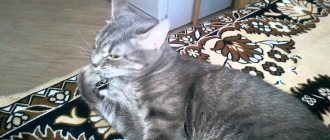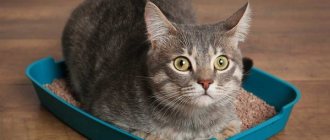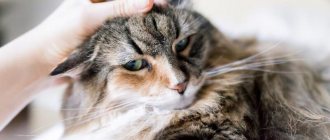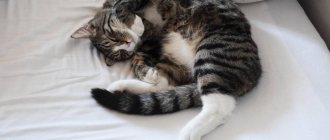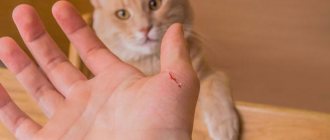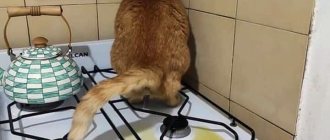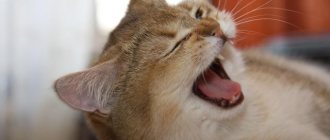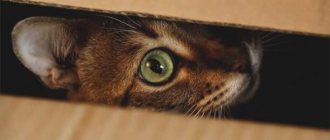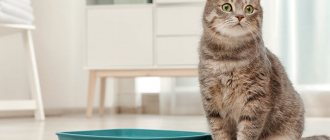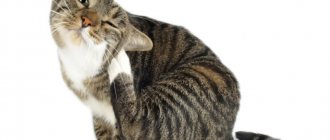It is known that cats are truly clean animals. It is natural for a cat to spend a lot of time grooming itself. A cat that bites its claws can look cute and touching. Sometimes this can be natural for the animal, since in this way the cat cleans its paw, making it clean. It happens that the claws are dirty, nothing more. But this behavior is not always natural for a pet. But not always, which also needs to be taken into account. In such cases, it would be a good idea for the owner to carefully examine the cat’s paws; there may be damage. Sometimes a cat will have to be weaned from this bad habit, just like a person. But first, you need to understand as accurately as possible why a cat bites its claws. Only in this way will it be possible to understand what can and should be done next.
The reasons why a cat bites its claws can be very different. Sometimes it is not a problem for the owner to cope on his own, but sometimes the pet will have to be taken to the veterinarian to help his beloved cat. Let's look at what reasons there may be when a cat bites its claws. Indeed, sometimes this can lead to negative consequences for the animal, even to the point that the cat injures its paw.
Why does a cat chew its claws?
Our mustachioed friends, cats, are very similar to ourselves, because they have some habits that are identical to humans.
One of them is the habit of biting its claws. However, when it comes to pets, they do this for a reason or out of boredom. A cat bites its claws due to certain problems or circumstances. So why do mustaches do this? There are 5 most common reasons for this :
- The pet has sore paws.
- The cat suffered significant stress for her.
- She lacks minerals.
- The mustachioed man is trying to get rid of his overly long claws.
- The animal has a fungal disease.
So, now let's look at each reason in more detail.
Why does a cat chew its hind legs?
Cats are very clean animals. Washing is their favorite pastime and they also lick their paws thoroughly, and if the cat is very fluffy, the fur often rolls between the fingers and the cat has difficulty gnawing out the pellets from there, here you can help - trim the fur. ..Another reason may be when their claws don’t wear well and they try to tear them off, that is, their claws are licked off or, to put it more correctly, they shed and the cat tears them off with its teeth. And the third reason is - look at the pads - there may be a tumor, cracks or fungus, but only a veterinarian can determine this with a special device.
Cats are very clean animals. Washing is their favorite pastime and they also lick their paws thoroughly, and if the cat is very fluffy, the fur often rolls between the fingers and the cat has difficulty gnawing out the pellets from there, here you can help - trim the fur. ..Another reason may be when their claws don’t wear well and they try to tear them off, that is, their claws are licked off or, to put it more correctly, they shed and the cat tears them off with its teeth. And the third reason is - look at the pads - there may be a tumor, cracks or fungus, but only a veterinarian can determine this with a special device.
Stressful situations
One of the most common causes of nail biting is stress. Of course, if a cat walks on the street, then it can experience a lot of trouble there. But those cats that live in an apartment can also encounter many problems in their life. The reasons that cause stress in a cat are often :
- guests unknown to her;
- the appearance of a new family member - a small child, another cat or another animal;
- changing of the living place;
- new owner;
- traveling by public transport or car;
- visit to the veterinarian;
- taking medications, especially forced ones, or any other health procedures.
If an animal bites its claws precisely because of stress, then it is necessary to identify the cause and eliminate it. Having come out of a stressful state, the cat will stop gnawing on them.
So, when do cats chew their claws?
The first and perhaps most common reason that a cat bites its claws is stress. A variety of factors can cause stress, including moving, a new owner, and the addition of new household members, such as other cats, dogs, or children. And if a cat goes outside freely, then there will definitely be no shortage of stressful situations for her. You should also add to the list a visit to the veterinarian, taking certain medications (especially if they involve forced administration and feeding of medication or forcibly restraining a cat), traveling by car, on public transport, or visiting strangers.
What is the reason for a cat's bad habit of biting its claws?
It should be noted that even people can bite their nails when stressed (for example, the legendary director Andrei Tarkovsky was famous for this habit), so it is not surprising that cats do the same. And if the cause of this behavior is indeed stress, then the only way to solve this problem is to identify the causes and eliminate them. If this cause of stress is eliminated, then soon the cat will stop biting its claws.
The second reason may be sore paws. Of course, not every disease of the limbs can lead to a cat biting its claws, but sometimes it happens, especially if it is the paws that are affected and not some other part of the limbs. This may be indicated by the fact that the cat bites its claws only on one or two paws
Observe the cat and which paws become the subject of its special attention, and if the pet’s attention is indeed concentrated on one paw, then it should definitely be shown to a veterinarian who can diagnose the problem and prescribe the appropriate treatment
Stress is the number one reason why a cat bites its claws.
The third reason is a lack of minerals, which the cat tries to compensate for by gnawing its claws. In this case, you also need to consult a veterinarian who will prescribe a vitamin and mineral complex for your cat. A similar problem often occurs in cats that are fed “at random” or “from the table” and a lack of minerals in this case is more likely to be the norm than the exception.
Another reason is infection.
The fourth reason is much more serious. This is a fungal infection that can destroy the nails. For example, with dermatomycosis, one can observe various lesions of the claws of a diffuse or focal nature in the form of foci of crumbly peeling, deformation and turbidity in various parts of the claw. As a rule, the claws of the forelimbs are affected. And if no measures are taken, the disease can last for several weeks or even months, being a source of infection for animals and people around the cat.
Finally, the fifth reason is that the claws are too long. Sometimes they grow so large that they even prevent the animal from moving. This is especially true for those cats that do not have access to the outdoors and whose claws do not wear down naturally. If the cat also leads a sedentary lifestyle, plays little and is not too zealous on the scratching post, then its claws can indeed become unusually long. In this case, you just need to help your pet trim its nails.
This is not at all difficult to do and a detailed description of this procedure can be found, like many other things, on our website. However, those owners who have enough free time and money can simply take their pet to a veterinarian who can carry out this procedure efficiently. You can also use the services of cat beauty salons or professional groomers, who can even come to your home.
Claw caps.
True, in some cases, their owners, who do not have sufficient experience in keeping cats, complain that when they trim their pet’s claws, they begin to crumble and delaminate. One of the reasons for this may be the lack of minerals already mentioned above (what to do in this case was also described above), and the other is scissors. A cat's claws should be shortened using a special nail clipper, which can be purchased at a pet store. As a last resort, you can use small wood cutters, but not scissors. If you use them, even very healthy claws will crumble and peel.
Big claws
Cats also chew their claws for a very simple reason: when they grow too big. This problem is especially acute for domestic cats who do not leave the apartment, since animals that walk on the street wear down their claws naturally. To solve this problem, you need to force your pet to lead an active lifestyle and play with it more often . You should also purchase a scratching post for your cat, on which he can sharpen his claws.
Another old and effective method to get rid of this problem is to regularly trim your pet’s nails. However, not many people manage to do it correctly, which is why a lot of other problems often arise due to sloppy haircuts. You can also avoid this kind of trouble by using special silicone caps, which have many advantages. With them:
- no need to cut the cat's claws;
- you can forget about scratching posts and scratched furniture;
- give your pet a very glamorous look, since multi-colored silicone attachments look very unusual on the paws of a mustachioed one.
Symptomatic treatment
Active scratching is always just a symptom signaling that the animal is experiencing discomfort. Effective treatment without identifying the root cause is impossible. Therefore, the animal will still have to be taken to the veterinarian. Based on the external examination and test results, the specialist will prescribe treatment.
So, in case of allergic reactions, an antihistamine will be prescribed. It is important to identify the allergen and eliminate it from the animal’s life.
For dermatitis, otitis, pyoderma, the doctor will prescribe antibiotics. In some cases, hormonal therapy is used (mainly treating scratches with hormonal ointments and creams).
For fungal diseases, antifungal agents are prescribed.
Acaricidal drugs effectively control ticks.
The most important thing for a quick recovery is to avoid scratching. To do this, you can use special mittens on the animal’s paws. You can buy them at pet stores. If your cat takes off her mittens, you need to trim her claws short.
To prevent bites, a special collar is used.
If the cause of itching is parasites, then not only the animal is treated with the drug, but also the places where it is located in the apartment: couches, rugs, rugs, beds.
It is important to carry out treatment comprehensively. The diet needs to be enriched with vitamins and microelements. For these purposes, special vitamin complexes or dietary supplements are suitable.
Fungal diseases
And finally, the last and very dangerous reason is a fungal infection. This disease is easy to detect because it often appears on the claws of the front paws. Taking a closer look at your pet's claws, you will be able to see their deformation, peeling, clouding and peeling. In advanced cases, the claw may even die. In addition, it should be remembered that a sick pet can become a source of infection for other animals or people. Therefore, you should definitely use the help of a specialist and follow all veterinary instructions.
In general, if you notice that your cat is biting its nails, you should not push this problem into the background. The sooner you deal with it, the easier it will be for you to avoid further troubles related to your pet’s health.
Symptomatic diet and procedures
To ensure that itching bothers your cat as little as possible, prevention is important. Experts recommend adhering to the following simple rules:
- The animal needs to be provided with healthy, balanced food. For these purposes, it is better to use specialized food.
- The cat should not be fed smoked meats, sausages, or junk food from the table.
- Regularly brush your cat, remove hair mats, and inspect the surface of the animal’s skin.
- Once every six months, treat the fur against parasites (relevant for animals that at least occasionally go out for a walk).
- Do not allow your cat to come into contact with street animals.
- Avoid situations in which your cat can taste or smell household chemicals.
- In case of insect bites, promptly treat the bitten area.
- Once a week, inspect your cat’s ears for mites and inflammation.
If a cat scratches and chews itself, this is not always bad. The desire to scratch is natural for animals. You should pay attention to your pet when scratching begins to interfere with a full life. Timely treatment will help your cat recover faster and prevent unpleasant complications associated with endless itching.
Injury to the claw, pad or toe
First of all, the owner needs to note whether the cat bites the claws on all paws indiscriminately or prefers the same one. If a pet persistently licks and bites a strictly defined limb, then you should carefully examine the fingers, claws and pads on it for:
- scratches, sores and cuts;
- inflammation of the interdigital membrane;
- stuck splinters, plant thorns, glass fragments and pieces of wire;
- broken and cracked claws;
- inflammation of the claw bed.
What to do. In simple cases, it is enough to treat the paw with an antiseptic solution (hydrogen peroxide, Chlorhexidine, Miramistin) and repeat the manipulation for several days until the wound is completely healed. Removal of foreign bodies and inflammation of the nail bed requires the assistance of a veterinarian.
When should you worry?
It's worth noting that you can't always tell when a cat is biting its claws. Your cat is not in sight 100% of the time. And some cats like a little privacy when grooming.
But if your otherwise healthy cat doesn't have proper nail care, she may resort to excessive chewing. Fixing this problem is not difficult - try a quality scratching post.
Beyond this simple solution, there are situations where nail biting is abnormal. This may be a sign of one or more medical conditions that require more urgent treatment. Excessive nail biting is usually associated with a medical or behavioral problem. So let's look at a few common problems and possible solutions to fix them.
Self-soothing remedy
Just like humans, cats can bite their claws when stressed.
The monotonous movements of the jaws are similar to the sucking reflex, which at a tender age guaranteed food and safety in the native nest next to the mother. This is why emotional and sensitive cats, having experienced trouble, put their paws in their mouths and do not take them out for a long time.
The psyche of apartment pets, kept in relative isolation and unfamiliar with a variety of stimuli, is especially fragile. Thus, an animal can experience severe stress due to:
- appearance of strangers;
- ongoing repairs;
- change of owner and place of residence;
- transportation;
- a visit to the veterinarian or to an exhibition;
- bathing and hygiene measures;
- injections and other medical procedures.
By analyzing recent events, you can identify the stress factor and become convinced of the psychological nature of the “bad habit.” As soon as the negative event is forgotten, the cat will stop gnawing its claws and calm down.
The pet is not eating properly or is simply sick
It also happens that a cat begins to bite its claws on both its front and hind paws. These may be signs that the animal is lacking certain vitamins or minerals in its diet. This is also a signal for the owner to make a more useful complex for the pet. But this is not the only reason; it happens that the pet is attacked by fungal diseases.
- In cases where the reasons have not been established, then it is better to contact a veterinarian. This way, the doctor will quickly tell you why cats start gnawing their claws and cannot stop;
- It is not always easy for the owner to distinguish between injuries and fungal diseases. Without paying attention to problems, you can bring the situation to a neglected state. Therefore, it is better not to delay, since a small problem with the nail can develop into serious problems;
- If a cat eats from the owner's table, then most likely the cat will not have enough vitamins. Since it is difficult to understand all the intricacies of a pet’s diet, it is enough to simply choose high-quality food that is suitable specifically for this animal;
- Fungal diseases in cats are the most dangerous. Infection of the nail can last for a long time, causing serious problems and not at all pleasing the pet with its general condition. It is not difficult to detect the disease, since the claws are affected by lesions and the surface begins to peel off.
All this leads to the fact that the cat begins to bite its claws and does not calm down, simply not finding a place for itself.
Lack of minerals
The desire to bite claws may be due to a lack of minerals in the body or their imbalance. Unable to find a more suitable source, the cat gnaws on mineralized parts of its own body. A similar condition is noted:
- with a poor, monotonous diet;
- during a period of intensive growth;
- during pregnancy and breastfeeding;
- after injuries during fracture healing;
- in case of poor calcium absorption and hormonal diseases.
Associated symptoms. An additional symptom of a lack of mineral nutrition is the instinctive need to lick, chew and swallow:
What should the owner do? To correct the situation, it is necessary to transfer the animal to a nutritious diet, using premium and super-premium food, and with natural feeding, provide high-quality vitamin and mineral premixes.
Nail biting is normal
Cats love to groom themselves. Part of this process involves washing the paws and getting them “between the toes,” so to speak. Cats will chew and bite their claws and toes to remove unwanted debris and detritus. This is especially noticeable in cats that love to spend time outdoors.
Cat's claws also have a special biological structure. This means that the outer layer of the nail becomes worn and worn away. Cats sometimes chew their claws to remove the outer layer of their nails. Underneath you will find a new layer with added sharpness and shine.
The bite works in tandem with other methods. Your cat may use scratching posts, outdoor tree bark, or your favorite couch to scratch or sharpen its claws. In general, cats like to keep them sharp, clean, and a healthy length.
© shutterstock
Fungal infections of claws
A fungal infection affects not only the skin and mucous membranes, but also the hairs and claws of animals. The claws of the front paws are especially affected, becoming:
- thickened and deformed;
- flaky and cloudy;
- crumbling and chipping.
In the severe stage of the disease, the crumpled claw dies.
How to help your pet. It should be remembered that fungal infections are very contagious, so a sick pet poses a danger to both its relatives and the owners themselves. That is why, in case of any suspicious behavior, you should show the cat to a veterinarian and undergo laboratory tests.
If everything is in order with the health of the mustachioed tabby, but the habit of biting its claws is too ingrained, then you can use colored silicone caps from the pet store. They are securely fixed on each claw with glue, giving the pet a glamorous look and weaning it from bad habits.
Unsharpened claws
The anatomical structure of cat claws provides for their constant growth and no less constant grinding. Cats with access to the outdoors wear off their claws in different ways:
- marking your own territory with “scratch” markers;
- overcoming various obstacles and climbing trees;
- realizing hunting instincts and grabbing prey;
- digging in the soil;
- moving in various gaits on hard ground.
Apartment cats can only partially realize their natural desires, so the problem of overgrown, unsharpened claws is very acute. Feeling discomfort, the animal becomes a forced “pedicure master,” biting the edges of its claws and tidying its paws.
Owner assistance. Felinologists advise purchasing scratching posts of various textures and shapes for apartment cats:
- horizontal;
- vertical;
- corner;
- in the form of columns.
This will help the pet realize its natural instinct to grind its claws down and at the same time not cause harm to the apartment interior.
Active hunting games, during which the cat sets up an ambush, jumps and excitedly claws its favorite toy, can effectively combat unsharpened claws.
Some owners regularly trim their cats' nails using clippers from a woman's manicure set or special nail clippers from a pet store.
Why does a cat bite its claws: physiological or psychological problems. How to help your pet?
How often do you see your cat sitting proudly on a cross, with her toes spread and her teeth diligently polishing her claws? The pet clamps each claw with its front incisors and cleans it with a characteristic clicking sound. Some owners are worried why a cat chews its claws, while others are puzzled by the fact that their pet does not pay attention to its manicure. Let's look at what's normal and when to worry.
A cat bites its claws - is this normal?
When people bite their nails, it is usually considered nervousness or just a bad habit. At worst, it is considered impolite or unsanitary.
Why do cats bite their claws? While this is generally considered normal, it can sometimes be a cause for concern for reasons we'll discuss below.
Cats chew their claws when grooming—after all, your cat likes cleanliness. However, excessive biting may be a sign of an underlying problem. It could be a behavioral problem caused by stress or anxiety.
But it could also be a medical problem that may require a visit to the vet. Either way, you'll want to keep an eye out for this behavior, as ignoring it can lead to more serious problems.
Read on to find out why cats chew their claws and when you should be concerned.
Causes
Quite rarely, but it happens that a cat bites its claws for no particular reason. By analogy with the “bad habit” of a person who bites his nails since childhood, out of boredom or excitement. In this case, the line between “normal” and “abnormal” behavior is very thin, since the process leads to complacency. In fact, how normal the chewer’s condition can be judged only by the depth of stress, and not by the length of the nails or the frequency of strange desires that arise.
Note! Some decorative breeds of cats have weak, thin claws. They rarely worry about sharpening and cleaning their claws and this is normal. In outbred cats, which have a highly developed hunting instinct, a lack of interest in claws may indicate an anxious state.
When a cat is bored or lonely, the situation may not be limited to biting its claws. Loneliness is a great stress for a domesticated animal, and if the owner does not find time for the pet for a long time, the cat feels abandoned. Against the background of an obsessive anxiety state, a pet can pull out tufts of hair, lick its limbs or comb its body until it bleeds , and surprise the owner with sharply negative actions.
Note! Active cats with a “cult of the owner” suffer from obsessive neuroses much more often.
Having studied the works of animal psychologists, we can conclude that biting claws may have causes related to:
- Personal hygiene – most often.
- Illness.
- Behavioral motives, stress, compulsive disorder - least often.
The main reasons why cats crush people with their paws, and the owner’s actions in case of such behavior
Affectionate furry pets have long gained the reputation of being one of the most mysterious and amazing creatures among domesticated animals. Cat breeders often note such a feature of their pet as the so-called “milk step”. Seeing these unusual movements, many people wonder why cats crush people with their paws.
Animal psychologists have several hypotheses about this peculiar ritual. A cat lover will be interested in finding an explanation for the unusual behavior of his affectionate couch potato.
Read in this article
Behavioral motives
A cat may chew its claws if they are not well-groomed. Make sure that the scratching post is in the pet’s constant access; if necessary, update the accessory. Don't forget to inspect your pet's claws once every 1-2 weeks. Claws that are too long and curved need to be shortened with a guillotine nail clipper or nail file.
Pets that walk outside should have their paws examined every day. If your cat appears anxious, make sure that:
- breaks or cracks on the claws - in the case of cracks, the condition should be monitored and, if possible, the claw should be trimmed (if the crack does not touch the blood vessels). If blood oozes from the injured nail or it interferes with the animal's ability to walk, we recommend contacting a veterinarian. By cutting a claw while it's alive, you will cause your pet a lot of pain and cause heavy bleeding. Without care and initial treatment, a short-cut claw is an open wound, which is fraught with infection.
- The pet has not injured a finger or paw - lameness, pain, attempts to bite its own paw and other behavioral oddities may indicate a sprained or torn ligament, fracture or other injury.
- Foreign object – while playing or walking, a cat can get a splinter that gets stuck under the skin. In winter weather, snow gets stuck between the cat's toes, which quickly turns into ice. The difficulty is that the ice causes great discomfort, and if these mini-snowballs contain salt and sand (which is sprinkled on footpaths), they also bake a lot. If a cat does not gnaw out the snow stuck between its toes in time, it risks chemical burns and frostbite.
In a state of severe stress, a cat tends to calm itself by licking. The process emits stroking and stimulates the nerve endings of the hair follicles. In response to licking, the cat's body produces endorphin. A cat that is stressed for a long time may lick areas of its limbs to the point of open wounds. The disease is called lick granuloma.
Note! A licked granuloma is not an injury, but the consequences of a psychological disorder. Treatment involves a complex of procedures: the affected areas are treated, the condition is treated symptomatically with the obligatory use of sedatives.
What to do?
If the case is advanced, the claw has grown into the finger, the pad of the finger is swollen, or the animal is in pain, the surest option is to contact a veterinary clinic to avoid complications. In such cases, surgery is indicated - the finger is opened and the claw is removed. Do not try to treat your pet yourself if your finger is inflamed and festered! This is fraught with blood poisoning and associated dangerous complications. The operation is not complicated, but it is better not to allow this to happen.
If it happened like it did for me, namely, the claw grew to the finger, slightly ate into it, but did not grow in, the finger does not hurt, the cat does not complain, you can try to deal with the problem yourself.
For this you will need:
- Antiseptic agents - napkins or just cotton wool and any disinfectant - alcohol, vodka, hydrogen peroxide, etc. What you will find in your home medicine cabinet.
- Scissors for trimming animal claws. I recommend that all cat owners have special scissors, since ordinary nail scissors are not suitable for a cat's claw - cutting with them can lead to cracking of the claw.
- If your cat is very restless, you can give him a natural cat sedative. I usually get by without it.
This is how pieces of the claw peeled off. So:
Fix the cat’s paw and sit him down so that the animal does not get nervous or twitch again. Treat your claw and finger with antiseptic just in case. Trim the claw carefully. When trimming, make sure the end of the claw extends freely from the pad of the toe.
If this does not happen, the depth of ingrowth is minimal, slightly pull the claw away from your finger. If it doesn't come out, don't try to pull it out. Grasp the claw with scissors at a distance of about 2-3 mm from the tip and trim it. If the claw is layered and large, trimming can take place in several stages. Cut the claw confidently, but not with all your might (to avoid cracks and injury). In my case, with the first effort, two layers of dead claw came off, and it became thinner. With the second press, another layer came off and the third time it was possible to cut off the first 3 mm. If in your case the claw is still ingrown, after separating it from the pad, try to carefully remove the ingrown piece with tweezers. If you correctly determine that the claw is not deeply embedded, everything should work out. If blood appears, treat your finger with a pre-prepared antiseptic.
That's not all. Since the claw is long, you need to trim it to the end. However, do not overdo it - the fact is that if the claw has not peeled off, it becomes opaque and the vessels are not visible through it. Don’t overdo it, it’s better to cut a little more and gradually remove the remaining length with a regular manicure file. And now that's it.
How to trim a cat's claws
In addition to the standard nail clippers, which are the first to be found in every pet store, there are several other tools for cat “pedicure”. List of products used for trimming nails
Table 2. Tools for cat pedicure
| Scissors | A classic and budget option, which cat owners most often limit themselves to. Manipulation with scissors does not cause any particular difficulties; their main disadvantage is the thickness of the blade, which increases the likelihood of capturing the sensitive part of the claw, equipped with blood vessels. |
| Wire cutters | This option differs from scissors by a special notch in the blades that adapts to the shape of a cat’s claw. With the help of nippers, it is much more difficult to make a mistake and injure a cat’s claw, due to their ergonomics and specialization for cats. |
| Guillotine trimmer | This specific tool is recommended for those cat owners who have already mastered the previous options and feel confident. The sharp blade of the trimmer extends when you press the handle and easily trims the tip of your pet's nail |
| Nail file | This remedy is well known to every person, but it is used least often on animals. However, it is the file that allows you to complete the work started with a nail clipper. In a cat pedicure, just like in a human pedicure, uneven corners may remain, which are smoothed out thanks to filing |
READ Vitamins with taurine for cats
The ritual of trimming the claws of kittens and adults is hardly different from each other. The only danger lies in the greater physical strength and sharpness of the teeth of an adult animal, which, if dissatisfied, can use them against you. Let's briefly go through the main stages of nail trimming:
- Before the procedure, make sure your hands and nail clipper are clean by lubricating them with alcohol. The use of rusty tools is strictly unacceptable;
Working with contaminated tools can, in the worst case, lead to blood poisoning in the animal. - Choose a well-lit room. Natural light is desirable, but if there is none, then a lamp will do;
- Take the cat in your arms and sit with him for a while, establishing contact and calming the pet. If he is wary even before the procedure begins, the process itself will be more difficult;
- Press two fingers on your pet's paw pads and inspect the claw that comes out. You should see the whitish tip of the claw slowly fade to a pale pink base. This is precisely what should not be affected;
A pink tint indicates that sensitive skin is hidden under the claw. - Determine in advance 2 mm from the beginning of the pulp and try it on using a tool. In this case, the instrument should be in the right hand of right-handers, in the left hand of left-handers;
- When holding a paw, do not press on it under any circumstances or change the force of pressure, since such changes will immediately cause anxiety in the pet and cause an instinctive desire to take the paw;
- Trim the claw by holding the tool perpendicular to it;
- If, after completing the procedure, you find uneven protrusions, treat them with a file;
- If your pet gets wounded, take a cotton pad and soak it in hydrogen peroxide. Place cotton wool on the cat's claw and hold it in your hands for a while.
Ignoring the fifth claw by the owner can lead to it growing into the animal’s skin
Important! Do not forget about the existence of a fifth claw, which, due to its location and size, usually remains hidden from the eyes of the owner. This claw wears down very slowly, but grows very quickly, which can one day cause it to dig into the cat's paw, causing pain and severe limping.
Medical reasons
As with any person or animal, medical problems come in many different forms. With any medical problem, it is best to let your veterinarian advise the best course of action. But it's worth knowing the possibilities.
From infections to pre-existing conditions, your cat may be suffering from one of the following:
- Pemphigus . Pemphigus is an autoimmune disease that affects the skin of cats. It is classified into five different subtypes. Pemphigus leaf is the type most commonly associated with cats. This manifests itself as irritation in sensitive areas such as the face (eyelids, nostrils, ears), genital area and yes, paws. The lesions appear on the toenails, forming painful, hard areas. The cat will try to lick or clean them, which will lead to excessive attention to the claws.
- Ringworm . Feline dermatophytosis is a relatively common skin disease. Despite its common name, it has nothing to do with worms. This is a fungal infection transferred from the soil. In many cases, fungi can be eliminated through regular maintenance.
- Other infections . Cats may also suffer from bacterial or yeast infections affecting their paws. Many may work unexpectedly. Some breeds are also genetically predisposed to certain conditions - for example, Persians are susceptible to a number of diseases; infections among them. Cats may also react to chemicals or detergents used to clean household surfaces.
- Nail problems in older cats . Older cats may have hormonal imbalances that cause their nails to become too thick or too brittle. They may also suffer from malignancies and tumors.
Alternative to trimming cats' nails
To radically solve the problem of scratching, veterinary clinics offer two types of surgical operations: onychectomy and tendectomy.
Surgery against cat nature
Nail amputation (onychectomy) is a major surgical operation under general anesthesia in which the claws and finger bones are removed. Postoperative healing lasts up to six months. As a result, your cat will become defenseless when attacked. She will forever lose her sense of balance, which makes her the most graceful animal in the world. She will bite for protection. The cat will feel pain when moving for the rest of its life.
inflammation of the foot of the front paw with swelling after onychectomy in a Sphynx cat
Complications can lead to paw amputation. Your pet's reaction to declawing surgery depends on her personality and overall health. Cats with good temperaments adapt to life without claws, while others unfortunately die. Owners, not wanting to care for a disabled animal, bring the cat to the clinic to be euthanized.
Amputation of claws is prohibited in 15 countries of the European Union and is considered cruelty to animals (European Convention, Article Ten).
Another surgical procedure to stop the scratching is a tendonectomy, or cutting out a piece of tendon in the finger, which will remain paralyzed forever. The cat will no longer be able to release its claws or sharpen them. These are no less painful consequences for the animal. There will be frequent fractures and other injuries due to the inability to maintain balance and lean on the paws during sudden movements.
Claws in covers
A safe veterinary invention for protection against sharp claws is soft caps made of silicone or vinyl, which are glued with special glue to the claws of a pet. They are called "anti-scratches". But due to the fact that there is no air access under the caps, inflammation may occur. The reason is the secretion of secretions by the sweat and sebaceous glands. Often cats remove the caps from their claws with their teeth due to a feeling of discomfort and swallow them.
Silicone covers on the claws of a British cat will not allow you to scratch the owner
Scratching devices
So that the cat can realize its instinct of scratching, without causing harm to the owners, you can make it yourself or buy it at a pet store, a scratching post or, as it is funny called, a scratcher. The scratching posts are made of wood and wrapped with thick twisted sisal or jute rope. If you decide to make your own scratching post, use a wood with vertical grains, such as elderberry, for the base. Cover it with a coarse cloth (the reverse side of an old carpet) and sew tightly with thick threads. Make a wooden stand or attach it to the wall, door frame, in other words, in those places where the cat scratches.
Types of cat sharpeners:
- floor;
- wall;
- rugs;
- horizontal figure eights with a stand.
It is not difficult to train a cat to scratch a scratching post instead of a sofa or wallpaper. Bring your pet to it and move your paw. Praise her if she starts scratching her. To attract your cat's attention to the post, you can rub it with the scent of a treat or catnip. It is better to seal the sofa with double-sided tape in places damaged by the pet. Let the cat choose what is more pleasant for her to scratch.
Photo gallery: claw grinders of various types of industrial production
It is important for a cat to define the boundaries of his possessions, so install several different scratching devices at the entrance to the room, near the sleeping place and the toilet. Cats like stands and rugs up to a meter high to show the enemy how big they are. That's why cats pull their paws up when scratching. Cats are interested in horizontal devices. Columns that reach the ceiling are suitable for those who like to climb higher.
Observing the movement of cat claws at the moment of scratching, I noticed that sharpening claws, cleaning them, or marking an object in the house with its scent are not the same thing. First, my favorite goes to the corner of the sofa. Extending its claws into the upholstery fabric, the cat then squeezes its fingers and hides the points in the folds of the skin before pulling it out. Excess scales remain in the fabric or fall to the floor. Consequently, she needs a sofa-like pad to clean her nails. Otherwise how to wean it off? I made a small one for testing using a board. I filled it with padding polyester and covered it with a piece of upholstery fabric. They fixed it on a thick stand. The height of my invention was slightly higher than the sofa. Unfortunately, the threads did not last long - after a month of use they broke. My cat tears at this pillow and rarely remembers the sofa. But to forget him completely, no! My territory is my sofa. Be patient, mistress.
This is interesting: Is it possible to give No-shpa to a cat?
